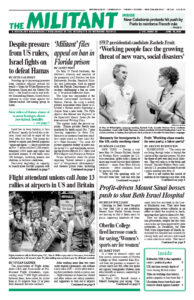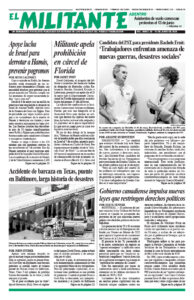Claiming its Beth Israel Hospital in New York City is not profitable, Mount Sinai Health System bosses are moving to shut it down piece by piece, impacting hundreds of thousands who live and work in the Lower Manhattan area. They have been implementing severe cutbacks in an effort to bleed the hospital to death, insisting they have to close it by July.
They are slashing services, staff and procedures, despite the fact their closure has not been approved by state authorities. In December, the New York State Department of Health determined the hospital was unlawfully closing beds and services and issued a cease-and-desist order. That hasn’t stopped the bosses.
Health workers at Beth Israel, whose names were protected to prevent retaliation, reported to Politico that programs continue to be terminated and the staff has dwindled from 1,800 to about 1,300 in less than a year. Many more saw the handwriting on the wall and are looking for new jobs. The workers said management is “quietly trying to ensure Beth Israel closes.”
Some floors are nearly empty. The hospital has stopped accepting a growing number of patients in its emergency department, canceled its on-call MRI service, let its ambulance contract lapse and halted outpatient surgeries.
These cuts have led to workers’ deaths. George Faust, a 76-year-old retired printer, fell out of a chair in January, resulting in broken ribs and a collapsed lung. After being rushed to Beth Israel, he was told the facility was too understaffed to care for a “trauma patient,” his wife, Kathleen Faust, told the New York Times. He eventually died after blood pooled in his lungs and abdomen after he was shuffled to two other hospitals.
Even though it is illegal to transfer patients in need of treatment, other cases cited by workers included gastrointestinal bleeding, gangrene, bowel obstruction, and one with an expanding muscle abscess who waited two hours to be moved elsewhere for surgery.
“We had a functioning hospital and then suddenly it was like we don’t,” one worker said.
Beth Israel began as a small clinic serving Jewish immigrants in the late 1800s and grew into one of the city’s largest hospitals.
Beth Israel isn’t making enough money because many of its patients are on Medicaid, Loren Riegelhaupt, a spokesman for Mount Sinai, told the media. In an effort to defend its “right” to shut the hospital, management insisted, “Refusing to allow a failing independent, nonprofit hospital to close is unconstitutional.”
Under capitalism medical care is treated like any other business — a way to generate profit for the hospitals, insurance and pharmaceutical bosses, not to provide treatment for the millions who need it.
Crisis of medical care in New York
Over the past 20 years, more than a dozen hospitals have closed in New York City. Many others have shut their doors in rural areas, subjecting workers living there to ever-greater travel distances to get any care. In April 2010 St. Vincent’s Hospital in Greenwich Village closed its doors. It had provided one of the busiest full-service emergency rooms in the city, giving care to many low-income and uninsured patients, especially when the explosion of the AIDS epidemic hit.
Three thousand workers, over half of them members of the Service Employees International Union Local 1199, lost their jobs. Just two months later North General Hospital in Harlem closed down, despite protests by workers and those who live in the community.
Currently on the chopping block is SUNY Downstate Medical Center in Brooklyn, the only state-run hospital in the city. State officials announced earlier this year they’re ramping down operations there.
By April, hospitals across the country had boosted their prices by 7.7% from a year ago, the biggest increase in 13 years. The cost for vital procedures continues to rise way above what many working people can afford. The average cost to get a stent in an artery to improve blood flow is now $15,650; intensive care for newborns can go for $7,900 a day; and breast biopsies using a needle are over $5,000. Meanwhile, health-insurance premiums have shot up at the fastest rate in a decade.
As prices soar, workers in the U.S. face lower life expectancy and the highest incidence of multiple chronic conditions among imperialist nations. This includes higher rates of maternal and infant deaths.
Medical care under capitalism is class-divided. In the U.S., the gap in life expectancy between the richest 1% and the poorest 1% is 15 years for men and 10 for women.

